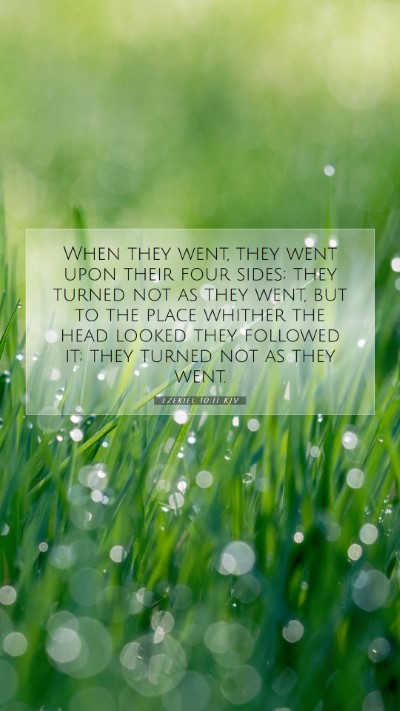Ezekiel 10:11 - Meaning and Interpretation
The verse Ezekiel 10:11 states, "When the cherubim went, the wheels went beside them; and when the cherubim lifted up their wings to mount up from the earth, the same wheels also turned not from beside them." This passage is rich with imagery and meaning, reflecting deep theological themes and insights into God's presence and mobility among His people.
Overview of Ezekiel 10:11
Ezekiel is a prophet whose visions and messages convey God's judgment and His ultimate restoration of Israel. In this particular verse, the movement of the cherubim and wheels signifies the divine presence and the glory of God departing from the temple in Jerusalem. This serves as a foreshadowing of the impending destruction, emphasizing the seriousness of Israel's disobedience.
Bible Verse Meanings
- Divine Mobility: The mobility of the cherubim and the wheels symbolizes God's omnipresence and His ability to move swiftly and decisively.
- God's Glory: The cherubim are often associated with God's glory. Their movement indicates that God's presence is not limited to the temple but can be found among His people wherever they are.
- Judgment and Separation: The departure of God’s glory signifies separation due to judgment, highlighting the consequences of sin.
Bible Verse Interpretations
In the commentaries of Matthew Henry, Albert Barnes, and Adam Clarke, several interpretations emerge:
- Matthew Henry's Commentary: Henry explains that the wheels represent the faithful execution of God’s commands, moving instantly with the cherubim, symbolizing divine authority in action.
- Albert Barnes' Notes: Barnes notes the importance of the wheels aligning with the cherubim, indicating that God's judgment proceeds with perfect harmony and order. The wheels signify the mechanisms of divine judgment at work.
- Adam Clarke's Commentary: Clarke elaborates on the imagery of the wheels in the context of the divine chariot, reflecting the majesty and grandeur of God's movement, symbolizing His active role in the world.
Understanding Scripture
This verse underscores a profound theological principle: God is actively involved in the affairs of humanity. His presence is portrayed through strong, dynamic imagery, which resonates with the theme of divine sovereignty and judgment throughout the book of Ezekiel.
Scripture Analysis
When analyzing Ezekiel 10:11, one must consider the historical context of Israel's disobedience and the subsequent consequences of turning away from God. This draws on significant themes of repentance, divine patience, and eventual judgment, marking a critical juncture in the spiritual narrative of Israel.
Biblical Exegesis
From a biblical exegesis perspective, the passage encourages readers to understand the prophetic warnings presented through Ezekiel. It calls for reflection on the current state of one’s relationship with God and the importance of remaining aligned with His will.
Bible Study Insights
For those engaged in Bible study groups or online Bible study, this verse can initiate discussions about God's judgment and grace, helping participants explore how to apply these themes to contemporary life. Questions for study may include:
- What does the imagery of the cherubim and wheels teach us about God's presence today?
- How does understanding this passage inform our view of divine judgment?
- In what ways can we align ourselves to avoid experiencing divine separation?
Cross References
Understanding Ezekiel 10:11 can be enriched by considering the following related Bible verses:
- Ezekiel 1:15-21: Discusses the vision of living creatures and wheels, providing insight into the divine chariot.
- Ezekiel 9:3: Mentions the glory of the God of Israel departing from the threshold of the temple.
- Revelation 4:6-8: Contains descriptions of similar cherub-like creatures around God's throne, linking Old and New Testament imagery.
Application of Ezekiel 10:11
In applying this verse to daily life, individuals can learn the importance of humility and the need for repentance. The departure of God's glory serves as a stark reminder of the consequences of sin, yet it also offers an invitation to experience restoration through sincere repentance and seeking God's presence.
Conclusion
Ezekiel 10:11 provides a rich tapestry of insights into divine dynamics. Through the interplay of the cherubim and wheels, we uncover themes of judgment, glory, and the mobility of God among His people. This passage not only calls us to understand the weight of sin but also inspires hope in the restoration made possible through Christ.


